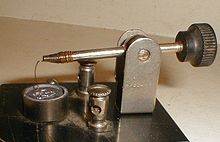
Back مكشاف بلوري Arabic Detector de galena Catalan Hrotová elektroda Czech Krystaldetektor Danish Kristaldetektilo Esperanto Detector de bigotes de gato Spanish آشکارساز کریستالی Persian 鉱石検波器 Japanese Kristaldetector Dutch Detektor kryształkowy Polish


A crystal detector is an obsolete electronic component used in some early 20th century radio receivers that consists of a piece of crystalline mineral which rectifies the alternating current radio signal.[1] It was employed as a detector (demodulator) to extract the audio modulation signal from the modulated carrier, to produce the sound in the earphones.[2] It was the first type of semiconductor diode,[3] and one of the first semiconductor electronic devices.[4] The most common type was the so-called cat's whisker detector, which consisted of a piece of crystalline mineral, usually galena (lead sulfide), with a fine wire touching its surface.[1][4][5]
The "asymmetric conduction" of electric current across electrical contacts between a crystal and a metal was discovered in 1874 by Karl Ferdinand Braun.[6] Crystals were first used as radio wave detectors in 1894 by Jagadish Chandra Bose in his microwave experiments.[7][8] Bose first patented a crystal detector in 1901.[9] The crystal detector was developed into a practical radio component mainly by G. W. Pickard,[4][10][11] who discovered crystal rectification in 1902 and found hundreds of crystalline substances that could be used in forming rectifying junctions.[2][12] The physical principles by which they worked were not understood at the time they were used,[13] but subsequent research into these primitive point contact semiconductor junctions in the 1930s and 1940s led to the development of modern semiconductor electronics.[1][4][14][15]
The unamplified radio receivers that used crystal detectors are called crystal radios.[16] The crystal radio was the first type of radio receiver that was used by the general public,[14] and became the most widely used type of radio until the 1920s.[17] It became obsolete with the development of vacuum tube receivers around 1920,[1][14] but continued to be used until World War II and remains a common educational project today thanks to its simple design.
- ^ a b c d Cite error: The named reference
Braunwas invoked but never defined (see the help page). - ^ a b Cite error: The named reference
Sievers1was invoked but never defined (see the help page). - ^ Cite error: The named reference
Hickmanwas invoked but never defined (see the help page). - ^ a b c d Lee, Thomas H. (2004). Planar Microwave Engineering: A Practical Guide to Theory, Measurement, and Circuits, Vol. 1. Cambridge University Press. pp. 4–9, 297–300. ISBN 978-0521835268.
- ^ U.S. patent 1,104,073 Greenleaf Whittier Pickard, Detector for Wireless Telegraphy and Telephony, filed: 21 June 1911, granted: 21 July 1914
- ^ Orton, John W. (2004). The Story of Semiconductors. Oxford University Press. pp. 20–23. ISBN 978-0198530831.
- ^ Seitz, Frederick; Einspruch, Norman (4 May 1998). The Tangled History of Silicon in Electronics. Silicon Materials Science and Technology: Proceedings of the Eighth International Symposium on Silicon Materials Science and Technology, Vol. 1. San Diego: The Electrochemical Society. pp. 73–74. ISBN 9781566771931. Retrieved 27 June 2018.
- ^ although at the microwave frequencies he used these detectors did not function as rectifying semiconductor diodes like later crystal detectors, but as a thermal detector called a bolometer. Lee, Thomas H. (2004). Planar Microwave Engineering: A Practical Guide to Theory, Measurement, and Circuits, Vol. 1. Cambridge University Press. pp. 4–5. ISBN 978-0521835268.
- ^ U.S. patent 755,840 Jagadis Chunder Bose, Detector for Electrical Disturbances, filed: 30 September 1901, granted 29 March 1904
- ^ U.S. patent 836,531 Greenleaf Whittier Pickard, Means for Receiving Intelligence Communicated by Electric Waves, filed: 30 August 1906, granted: 20 November 1906
- ^ Douglas, Alan (April 1981). "The Crystal Detector". IEEE Spectrum. 18 (4): 64–69. doi:10.1109/MSPEC.1981.6369482. ISSN 0018-9235. S2CID 44288637. archived: part1, part2, part3, part4
- ^ Pickard, Greenleaf Whittier (August 1919). "How I Invented the Crystal Detector" (PDF). Electrical Experimenter. 7 (4): 325–330, 360. Retrieved 13 June 2016.
- ^ Riordan, Michael; Lillian Hoddeson (1988). Crystal fire: the invention of the transistor and the birth of the information age. USA: W. W. Norton & Company. pp. 19–21, 92. ISBN 978-0-393-31851-7.
- ^ a b c Basalla, George (1988). The Evolution of Technology. UK: Cambridge University Press. pp. 44–45. ISBN 978-0-521-29681-6.
- ^ Winston, Brian (2016). Misunderstanding Media. Routledge. pp. 256–259. ISBN 978-1315512198.
- ^ Sterling, Christopher H.; O'Del, Cary (2010). The Concise Encyclopedia of American Radio. Routledge. pp. 199–201. ISBN 978-1135176846.
- ^ "...crystal detectors have been used [in receivers] in greater numbers than any other [type of detector] since about 1907." Marriott, Robert H. (September 17, 1915). "United States Radio Development". Proceedings of the Institute of Radio Engineers. 5 (3): 184. doi:10.1109/jrproc.1917.217311. S2CID 51644366. Retrieved 2010-01-19.